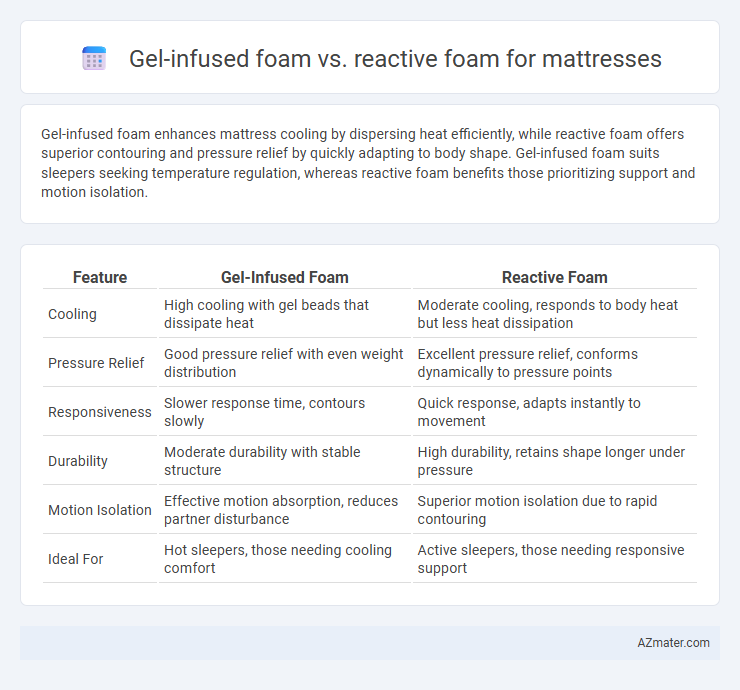Gel-infused foam enhances mattress cooling by dispersing heat efficiently, while reactive foam offers superior contouring and pressure relief by quickly adapting to body shape. Gel-infused foam suits sleepers seeking temperature regulation, whereas reactive foam benefits those prioritizing support and motion isolation.
Table of Comparison
| Feature | Gel-Infused Foam | Reactive Foam |
|---|---|---|
| Cooling | High cooling with gel beads that dissipate heat | Moderate cooling, responds to body heat but less heat dissipation |
| Pressure Relief | Good pressure relief with even weight distribution | Excellent pressure relief, conforms dynamically to pressure points |
| Responsiveness | Slower response time, contours slowly | Quick response, adapts instantly to movement |
| Durability | Moderate durability with stable structure | High durability, retains shape longer under pressure |
| Motion Isolation | Effective motion absorption, reduces partner disturbance | Superior motion isolation due to rapid contouring |
| Ideal For | Hot sleepers, those needing cooling comfort | Active sleepers, those needing responsive support |
Introduction: Understanding Modern Mattress Foams
Gel-infused foam incorporates cooling gel beads that enhance airflow and dissipate heat, providing a cooler sleep surface compared to traditional reactive foam. Reactive foam, often referred to as memory foam, responds to body heat and pressure to contour closely, offering targeted support and pressure relief. Both foams aim to improve comfort and spinal alignment, but gel-infused foam excels in temperature regulation while reactive foam is valued for its adaptive responsiveness.
What is Gel-Infused Foam?
Gel-infused foam is a type of memory foam that incorporates gel beads or gel swirls designed to improve temperature regulation by dissipating heat more effectively than traditional foam. This material enhances breathability and provides a cooler sleep surface, making it ideal for individuals who tend to overheat during the night. Compared to reactive foam, which responds primarily to body heat and pressure for contouring, gel-infused foam offers a balance of temperature control and pressure relief for enhanced overall comfort.
What is Reactive Foam?
Reactive foam, also known as memory foam, is a viscoelastic material that responds to body heat and pressure, contouring closely to the sleeper's shape to provide personalized support and pressure relief. Unlike gel-infused foam, which incorporates cooling gel beads to enhance temperature regulation, reactive foam adapts slowly to movements, ensuring durability and reduced motion transfer. Its density and viscosity make it especially effective for alleviating pressure points and improving spinal alignment during sleep.
Cooling and Temperature Regulation
Gel-infused foam mattresses excel at cooling and temperature regulation by incorporating gel particles that dissipate heat and enhance airflow, preventing overheating during sleep. Reactive foam, also known as memory foam, contours to the body but tends to retain heat due to its dense structure, which can limit breathability and lead to warmer sleeping conditions. Choosing gel-infused foam ensures a cooler sleep surface with improved breathability, while reactive foam prioritizes body contouring with less effective temperature control.
Pressure Relief and Support Comparison
Gel-infused foam offers superior pressure relief by evenly distributing body weight and reducing heat retention, enhancing comfort and support throughout the night. Reactive foam, also known as memory foam, provides excellent contouring that closely adapts to body shape, delivering targeted support and minimizing pressure points. Comparing both, gel-infused foam excels in cooling and consistent firmness, while reactive foam is favored for its deep conforming ability and motion isolation.
Motion Isolation Capabilities
Gel-infused foam mattresses excel in motion isolation by absorbing and dispersing movement, reducing the transfer of motion across the bed. Reactive foam, known for its quick responsiveness, also provides effective motion isolation but tends to be slightly less efficient than gel-infused foam in minimizing disturbances caused by a partner's movement. Selecting gel-infused foam mattress can enhance uninterrupted sleep for couples sensitive to motion transfer.
Durability and Longevity
Gel-infused foam mattresses typically offer enhanced durability due to their ability to maintain structural integrity and resist sagging over time, thanks to the gel infusion that helps regulate temperature and improve foam resilience. Reactive foam, often known as memory foam, provides excellent contouring and pressure relief but may degrade faster under constant use, especially if it lacks added cooling components. Choosing gel-infused foam can result in longer mattress lifespan and sustained comfort, especially in warmer climates or for heavier sleepers.
Allergy and Odor Resistance
Gel-infused foam mattresses offer superior allergy resistance due to their antimicrobial properties that inhibit dust mites, mold, and bacteria growth, creating a healthier sleeping environment for sensitive individuals. Reactive foam, often known as memory foam, can retain heat and moisture, which may promote odor retention and allergen buildup if not treated with antimicrobial additives. Choosing gel-infused foam enhances odor control and minimizes allergen triggers, making it a preferred option for allergy sufferers.
Price and Value Considerations
Gel-infused foam mattresses typically offer better temperature regulation and pressure relief at a moderate price point, making them a popular choice for buyers seeking enhanced comfort without a premium cost. Reactive foam mattresses prioritize responsiveness and support, often resulting in higher prices but delivering long-term durability and adaptive support. Comparing price and value, gel-infused foam provides an affordable balance of cooling and comfort, while reactive foam justifies its cost with superior support and longevity.
Choosing the Right Foam for Your Sleep Needs
Gel-infused foam offers enhanced cooling properties by dissipating heat and maintaining a comfortable sleep temperature, ideal for hot sleepers. Reactive foam, also known as memory foam, provides superior pressure relief and contouring support by responding to body heat and weight, perfect for those with joint pain or specific support needs. Selecting the right foam depends on prioritizing either temperature regulation or personalized support to optimize sleep quality.

Infographic: Gel-infused foam vs Reactive foam for Mattress
 azmater.com
azmater.com